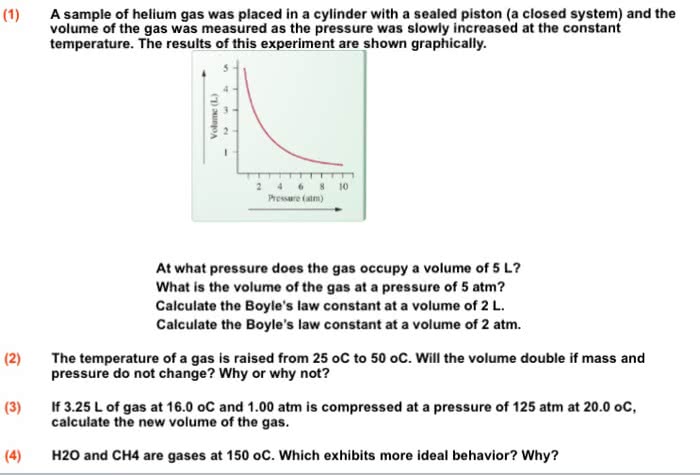CHEM 1040L Lecture Notes - Lecture 12: Ideal Gas Law, Pressure Sensor

Experiment 12
Introduction
The objectives of Experiment Twelve are to demonstrate Boyle's Law by measuring the
pressure of gas (air) while varying volume, and to observe Aoto’s Law by measuring the
pressure of gas while varying the temperature in closed systems. This was accomplished by
using a syringe to create varying amounts of pressure. The MeasureNet system then recorded
the pressure as the volume was changed, as well as recording the temperature as the pressure
flask was submerged and cooled in water. The concepts that related to lecture included were
Boyle's Law, Charles' Law, and Dalton's Law. The techniques that related to lab included using a
stir plate, using the MeasureNet system to record pressure, volume, and temperature values,
measuring pressure with a pressure sensor, and creating pressure by using a syringe in a closed
system.
Experimental Procedure
The experimental procedure was downloaded and printed off of Chem21labs.com, titled
"Experiment Twelve: Behavior of Gases." It came from pages 12-6 through 12-9. The
procedures were followed exactly as they were stated in the handout.
Results
Atmospheric Pressure 758.4 atm
Questions
1. The graph was used to determine the Vtubing value because Vtubing on the graph is
the opposite sign of the equation's y-intercept, when using the graph plot of Vsyringe
vs. 1/Pair.
2. The plots generated by manipulating Pair and Vair that demonstrate Boyle's Law were
Pair vs. 1/ Vair and Vair vs. 1/Pair because the law state's that pressure and volume are
inversely proportional. This is show because the graph had the equation y=1637.6x+1E-
05, which is similar to x^-1.
3. Rearrangement of the Ideal Gas Law equals: P=nRT/V. The slope of the line of my
equation represents the multiplication of the "N, R, T". So therefore slope= nRT.
4.
5. Grasping the barrel of the end of the syringe can influence the pressure measurements.
This is so because since there is a direct relationship between temperature and
pressure, temperature from your hand, holding it anywhere besides the base, can
cause the syringe to warm up, thus altering the pressure reading by increasing the
pressure.
6. The value of k= the y intercept Pair divided slope of Pair/Temp units. K was found to be
456.47. So, by adding 273.15K to Kappa to get the answer in Kelvins, you get
456.7+273.15=729.61K.
find more resources at oneclass.com
find more resources at oneclass.com
Document Summary
The objectives of experiment twelve are to demonstrate boyle"s law by measuring the pressure of gas (air) while varying volume, and to observe a(cid:373)o(cid:374)to(cid:374)"s law by measuring the pressure of gas while varying the temperature in closed systems. This was accomplished by using a syringe to create varying amounts of pressure. The measurenet system then recorded the pressure as the volume was changed, as well as recording the temperature as the pressure flask was submerged and cooled in water. The concepts that related to lecture included were. The techniques that related to lab included using a stir plate, using the measurenet system to record pressure, volume, and temperature values, measuring pressure with a pressure sensor, and creating pressure by using a syringe in a closed system. The experimental procedure was downloaded and printed off of chem21labs. com, titled. The procedures were followed exactly as they were stated in the handout.


